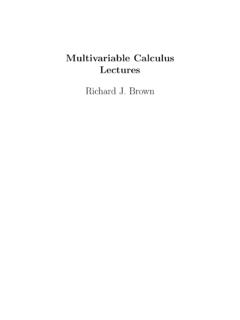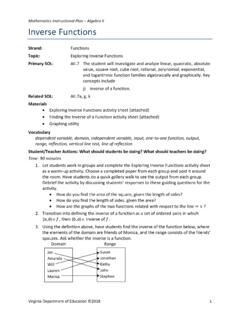Transcription of Lemma 0.27: Composition of Bijections is a Bijection
1 Lemma : Composition of Bijections is a BijectionJordan PaschkeLemma :LetA,B, andCbe sets and suppose that there are bijective correspondences betweenAandB, and betweenBandC. Then there is a bijective correspondence :Suppose there are bijectionsf:A Bandg:B C, and defineh= (g f) :A C. We willshow thathis a first show thathis surjective, that is thathis onto. Recall that since sincefandgare both Bijections (and hence surjections), we have thatf(A) =Bandg(B) =C. Therefore we also have thath(A) = (g f)(A)def={c C|(g f)(a) =c, for somea A}={c C|g(f(a)) =c, for somea A}={c C|g(b) =c, for someb f(A)}def=g(f(A))=g(B)=Cand hencehis also we will show thathis injective. That is, we will show that ifh(a) =h(a ), then we must have thata=a . Suppose thath(a) =h(a ). By our definition ofhthis means thatg(f(a)) =g(f(a )).
2 However,bothfandgare injective (since they are Bijections ) and sog(f(a)) =g(f(a )) = f(a) =f(a )= a=a ,and hencehis both surjective (onto) and injective (1-to-1), thenhis a Bijection , and the setsAandCare inbijective that we have never explicitly shown that the Composition of two functions is again a function. To save on time andink, we are leaving that proof to be independently verified by the this argument, I claimed that the sets{c C|g(f(a)) =c, for somea A}and{c C|g(b) =c, for someb f(A)}are equal. In general, the proper way to show that two sets,XandY, are equal is to show that bothX YandY showing this double inclusion explicitly for the sets mentioned above. One way should be immediately clear, and the otherrequires thatfis makes this a good proof?Constructing a well-written proof is one of the more difficult aspects of a being a successful math stu-dents.
3 Much like other types of writing, proof writing is somewhat of an art, and it takes a lot of reworkingto get it perfect. The hallmark of a good proof is the perfect blend of clarity and elegance. It is easy to findmany extreme examples in either direction; either with writing that is very terse and hard to follow, or thatis so wordy and clunky that it is easy to get can be hard to pinpoint what exactly was done right in any particular proof, and there is certainly no formula that can guarantee you a well-written argument. To that end I will merely point out some of theaspects of my proof that I feel are applicable in a broader sense, and that I feel are good goals to have whenwriting most proofs. The proof begins with a restatement of the initial hypotheses. Restating the theorem word-for-word isnot always necessary, but you should always provide the reader with the proper set-up for the all your hypotheses and assumptions/suppositions is a good way to begin any proof.
4 I gave names to all of the important objects ( points, functions, sets, etc.) that I will be referencinglater in the proof. This lets us quickly refer to the objects by name, rather thandescribingthem eachtime, or having to refer to them in some other nebulous way. Before I get into the heart of the proof, I briefly mention what it is that we re trying to prove. If youjust dive right in and don t tell the reader where you intend on going, the reader is much more likelyto get lost in the details, never having seen the intended goal. I recall the important aspects of the functionsfandgwhen they are needed (for example, thatbeing a Bijection also includes being a surjection.) This is more of an issue of style, however; I preferto remind my readers of important facts while they go, rather that just hoping they remember themon their own.
5 That being said, there is a fine balance between telling the reader too much, and nottelling them enough. A reader might feel like you are talking down to them if you constantly remindthem of even the most simple facts; but leaving the reader entirely to follow along on their own canleave them feeling lost. You will have to find your own balance as you hone your proof-writing skillsthroughout this course. It is important to use definitions and notation well. There will bea lotof symbology and terminologyin this class, all of which is there for a particular reason. Every definition or symbol we see is there tohelp us prove or understand something, and most of them are incredibly specific. Unlike an Englishessay, where you can use many words to elaborate on a topic, or to say the same thing in many differentways, proof writing needs to be razor-sharp.
6 And this is really only possible with precise definitionsand an agreed upon set of notation is particularly important. Please make sureyou are as comfortable writing with it as you are with writing English sentences. When I have shown a particularly important part of of the argument, I emphasized it with a is my style, and certainly not expected of you. Try developing your own style while writing. After everything has been shown, and we have reached the end of the argument, I summarize the resultsand recap with what I was trying to prove from the beginning. The symbol or is commonly usedat the end of a proof to indicate to the reader that a proof has been finished. This breaks up the proofvisually, especially when it is inside a textbook, among other writing and expositions.
7 The also frequently used, which stand for the Latin phrase, quod erat demonstrandum ( thatwhich was to be demonstrated ).2











